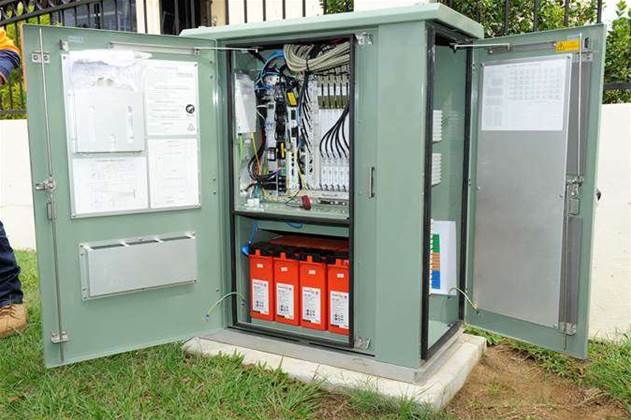Take-up rates in the first NBN fibre-to-the-node (FTTN) areas are outstripping those seen in the early fibre-to-the-premises (FTTP) footprint, new figures reveal.

The federal government quietly provided the first detailed look at NBN take-up rates in FTTN service areas via a set of documents published to the Department of Communications’ disclosure log earlier this month.
The documents offer a partial examination of the NBN rollout fortunes of mostly Coalition-held seats since the 2013 election.
However, they provide an almost complete picture of FTTN take-up on the NBN to the end of February 2016, accounting for 19,986 of a known 23,232 activations at that time.
An analysis of the figures by iTnews shows that top FTTN suburbs are achieving higher take-up rates in less time than it took for early FTTP areas to reach similar levels.
| FTTP | RFS | Time Elapsed | Take-up (%) | FTTN | RFS | Time Elapsed | Take-up (%) | |
| 7KIN-01 | 23/11/12 | 18 weeks | 37.4 | 2BLT-05 | 4/12/15 | 13 weeks | 42.57 | |
| 3SMR-03 | 23/11/12 | 18 weeks | 35.7 | 2BLR-01 | 25/12/15 | 10 weeks | 38.27 | |
| 7SOR-01 | 23/11/12 | 18 weeks | 34.5 | 2BLT-07 | 13/11/15 | 16 weeks | 36.95 | |
| 7GEW-01 | 23/11/12 | 18 weeks | 31.7 | 2GRK-01 | 9/10/15 | 21 weeks | 36.87 | |
| 7DEL-01 | 23/11/12 | 18 weeks | 29.6 | 2BLT-06 | 4/12/15 | 13 weeks | 35.63 | |
| 7TRA-01 | 23/11/12 | 18 weeks | 28.7 | 2GRK-02 | 30/10/15 | 18 weeks | 35.47 | |
| 7STH-01 | 23/11/12 | 18 weeks | 17.9 | 2GRK-06 | 20/11/15 | 15 weeks | 34.64 | |
| 9CRC-06 | 30/1/13 | 8.5 weeks | 15.9 | 2BLR-02 | 25/12/15 | 10 weeks | 34.08 | |
| 9CRC-03 | 17/1/13 | 10.5 weeks | 13.9 | 2BLT-10 | 13/11/15 | 16 weeks | 32.51 | |
| 2ARM-05 | 17/1/13 | 10.5 weeks | 12.4 | 2GRK-03 | 13/11/15 | 16 weeks | 31.44 | |
| 7HOB-01 | 29/3/13 | 2 days | 10.5 | 2BLT-01 | 27/11/15 | 14 weeks | 30.36 | |
| 2CFS-01 | 17/1/13 | 10.5 weeks | 10.3 | 2BLT-04 | 4/12/15 | 13 weeks | 28.69 | |
| 3SMR-02 | 5/4/13 | -1 week | 8.3 | 2BLT-08 | 4/12/15 | 13 weeks | 28.08 |
FTTN vs FTTP
The FTTN dataset provides an interesting opportunity to compare the take-up of fibre-to-the-node to that of fibre-to-the-premises in its early days.
To do that, we used 2012-13 data released by NBN to a parliamentary committee, as it provides similar take-up data for fibre-serving area modules in the first few months after they were declared ready for service.
iTnews analysed the fibre take-up numbers at the time, noting soaring take-up rates in NBN Co’s top 22 fibre serving area modules.
The FTTP data covers the fastest growing areas by take-up at that time. It almost certainly represents the best-case scenario for rapid take-up of FTTP in early 2013.
As we now similarly have a good representative sample of FTTN data, we’re able to similarly compare how top FTTN areas are faring in take-up terms.
The results are strong: early FTTN take-up rates are outpacing those of early FTTP.
In addition, for areas where little time elapsed between the ready for service (RFS) date and when the data was pulled, FTTN and FTTP take-up is broadly similar.
NBN Co’s FTTN vs FTTP take-up rates are proof that the company’s focus on getting more people actively using the network - rather than chasing premises passed - is paying dividends.
In February this year, NBN said it broke 10,000 activations a week over a “12-week rolling average” and predicted the rate would continue to climb.
Just one quarter later, it reported average activations of 14,000 new premises each week.
“NBN is ahead of plan on activations, which is translating through to improved earnings,” CEO Bill Morrow said.
Read on to page two for a complete breakdown of the FTTN data by area


.png&h=140&w=231&c=1&s=0)


_(20).jpg&h=140&w=231&c=1&s=0)





 iTnews Executive Retreat - Security Leaders Edition
iTnews Executive Retreat - Security Leaders Edition












_(1).jpg&h=140&w=231&c=1&s=0)



